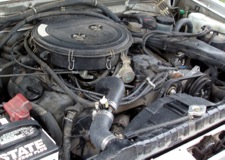 Recently, an old customer called to tell me his 1988 Nissan Pathfinder “fishing wagon” wouldn’t crank. Reliability is a must because he uses this vintage vehicle during the summer to go fishing in high mountain lakes. The Pathfinder’s battery was less than one year old and passed a preliminary conductance test with flying colors.
Recently, an old customer called to tell me his 1988 Nissan Pathfinder “fishing wagon” wouldn’t crank. Reliability is a must because he uses this vintage vehicle during the summer to go fishing in high mountain lakes. The Pathfinder’s battery was less than one year old and passed a preliminary conductance test with flying colors.
The Pathfinder’s starter activation system is typical for many import vehicles of this vintage. In the manual transmission version, the ignition switch supplies power to the clutch switch relay windings when in the crank position. When the clutch pedal is fully depressed, the clutch safety switch grounds the relay windings, which closes the relay and supplies current to the starter solenoid. With the relay closed, the starter solenoid mechanically engages the starter pinion gear with the engine flywheel and also closes the contacts that supply current from the battery to the starter motor. See Photo 1.
An inductive amp clamp revealed that the amperage draw on the starter was about 25 amps, which included the fuel pump and ignition draw. While not perfectly accurate, this test indicated that the clutch switch, clutch switch relay and starter solenoid were activating. With 186,000 miles on the odometer, it was highly likely that either the electrical contacts in the solenoid were burned out or that the starter motor brushes were worn out.
BATTERY RATINGS

Looking at the bigger picture, battery ratings are an essential part of testing batteries and starters. Just for the record, the cranking amp (CA) rating is the amperage that a battery will produce for 30 seconds at 32° F. The cold-cranking amperage (CCA) rating is the amperes the battery will produce for 30 seconds at 0° F.
If we do the math, the CCA is about 80% of the CA, which indicates that the battery is 20% less efficient at 0° F. In the real world, a battery can become much less efficient at 0° F. The difference between CA and CCA is important because modern electronic conductance testing requires a CCA rating input, as does the old-school adjustable carbon pile load tester.

BATTERY CHARGING NOTES
A fully charged battery is required for testing starters. Restoring a battery to a full state of charge (SOC) requires three charging modes: bulk, absorption and float.
The bulk mode is characterized by high amperage flow and low terminal voltage. The absorption mode is characterized by lower amperage flow at 14.4 terminal volts. The float mode is a maintenance mode characterized by very low amperage flow at 13.2 to 13.4 terminal volts. Eighty percent of the charging is done in the bulk mode. But, to reach a full SOC, the charging process must include the absorption and float modes.
Many modern “smart” battery chargers include all three modes and many PCM-based charging management strategies can include similar modes. Remember that a “surface charge” remains after the battery charger has been disconnected. Surface charge can be removed by turning on the vehicle’s headlamps for a few minutes or by loading the battery with a carbon pile load tester. If fully charged and in good condition, the terminal voltage should rise to 12.60 volts after a mild discharge. See Photo 2.
MODERN BATTERY TESTING
In brief, conductance testing consists of passing a mild alternating current through the battery to measure battery plate resistance or impedance. Plate resistance is then mathematically extrapolated into CCA. See Photo 3.

To illustrate, I tested four batteries from my personal vehicles, all of which are the same brand and with 60-month warranty periods. To verify the conductance tests, I followed with an old-school adjustable carbon pile load test. While my conductance tester might display information in a slightly different format than other testers, the indications will generally be the same.
Battery “A” from one of my collector cars is rated at 540 CCA and has a purchase date of March 2002. After a 48-hour float charge, the terminal voltage had risen only to 12.44 volts, which is only about 75% of normal charge. See Photo 4.
A good battery at room temperature with no electrical load should have risen to about 12.60 terminal volts, which is a full charge. A conductance test indicated 8.5m ohms of impedance. A carbon pile test at 270 amperes (one-half of rated CCA) drew the terminal voltage down to 8.5 volts during a standard test time of 15 seconds. Since the minimum threshold is 9.5 volts, this battery would likely crank an engine in warm weather, but would likely fail in sub-freezing weather.

The new replacement battery “B” is rated at 550 CCA with a replacement date of June 2012. A conductance test indicated 615 CCA or 111% of the rated CCA. Terminal voltage is 12.6 volts, indicating a full charge and an impedance of 5.22m ohms. The carbon pile test values were 270 amps for 15 seconds while maintaining 9.7 volts at the battery terminals.
Similarly, battery “C,” rated at 500 CCA, has been in daily service since January 2011. Conductance testing indicated 640 CCA, or 128% of the rated CCA, with a plate impedance of 5.0m ohms. A carbon pile load test at 250 amps for 15 seconds produced 9.7 volts at the battery terminals.
CONCLUSIONS
The 10-year-old battery “A” was damaged by plate sulfation, which is caused by disuse and a continuous low SOC. Like all new batteries, battery “B” produces well over its rated CCA. Similarly, battery “C” has been driven for about 18 months and still produces 128% of its rated CCA. I always test new batteries before installation just to be sure that the CCA is above their advertised values.
MODERN STARTER TESTING
Although modern engine starters are generally permanent-magnet, reduction-gear designs, many older vehicles are equipped with field coil starters. To illustrate the difference, I tested a 3.0 L V6 equipped with a permanent magnet starter in good condition. Its new battery is rated at 650 CCA and tested at 842 CCA with 3.82m ohms plate impedance.
The initial battery voltage was 12.51 volts and at a 50-amp draw, the voltage dropped to 12.15 volts. The average cranking voltage was 11.28 volts, with the minimum at 11.16 volts. The maximum initial cranking amperage was 161.0 amperes with an average of 114 amperes during a 7-second extended cranking test. See Photo 5.
Next, I compared a 2.8 L V6 equipped with a field coil starter in good condition. The battery had been in service 18 months, is rated at 500 CCA, and tests at 640 CCA with an impedance of 5.00m ohms. Initial voltage was 12.48 volts and, after a 50-amp load, dropped to 12.10 volts. The average cranking voltage was 10.87 volts with the minimum at 10.84 volts. Maximum cranking amperage was 205.0 amps and the average was 180 amps during a 7-second extended cranking test.
In conclusion, the field coil starter was drawing nearly 150% more amperage than the permanent magnet starter. Also, keep in mind that the larger engine displacements and higher compression ratios will increase cranking amperages. Most important, neither minimum cranking voltage fell below 10.0 volts. Remember that only a battery and starter in good condition will maintain the high cranking voltages needed to maintain a full range of PCM functions.
THE DIAGNOSTIC SUMMARY

The starter amperage draw on the 3.0 L, 1988 Pathfinder was about 25 amps, including fuel pump and ignition draw. Because a mild tap or engine vibration would reactivate the starter, I would speculate that the starter brushes were losing contact with the starter motor commutator. See Photo 6.
The clutch switch relay was replaced as required by the starter warranty. Due to a high intermittent voltage drop on the clutch switch circuit, I replaced the clutch switch as well. A week after the repair, the owner informed me that his Pathfinder had again quit cranking. Testing indicated that the clutch switch was activating and that zero amperage was flowing through the starter. A warranty replacement cured the problem and the veteran Nissan Pathfinder is now on its way to our high mountain lakes in pursuit of fresh trout and the pure joy of being in our great out-of-doors.












